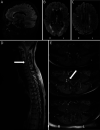Is MS affecting the CNS only? Lessons from clinic to myelin pathophysiology
- PMID: 33234720
- PMCID: PMC7803330
- DOI: 10.1212/NXI.0000000000000914
Is MS affecting the CNS only? Lessons from clinic to myelin pathophysiology
Abstract
MS is regarded as a disease of the CNS where a combination of demyelination, inflammation, and axonal degeneration results in neurologic disability. However, various studies have also shown that the peripheral nervous system (PNS) can be involved in MS, expanding the consequences of this disorder outside the brain and spinal cord, and providing food for thought to the still unanswered questions about MS origin and treatment. Here, we review the emerging concept of PNS involvement in MS by looking at it from a clinical, molecular, and biochemical point of view. Clinical, pathologic, electrophysiologic, and imaging studies give evidence that the PNS is functionally affected during MS and suggest that the disease might be part of a spectrum of demyelinating disorders instead of being a distinct entity. At the molecular level, similarities between the anatomic structure of the myelin and its interaction with axons in CNS and PNS are evident. In addition, a number of biochemical alterations that affect the myelin during MS can be assumed to be shared between CNS and PNS. Involvement of the PNS as a relevant disease target in MS pathology may have consequences for reaching the diagnosis and for therapeutic approaches of patients with MS. Hence, future MS studies should pay attention to the involvement of the PNS, i.e., its myelin, in MS pathogenesis, which could advance MS research.
Copyright © 2020 The Author(s). Published by Wolters Kluwer Health, Inc. on behalf of the American Academy of Neurology.
Figures



References
-
- Koch-Henriksen N, Sørensen PS. The changing demographic pattern of multiple sclerosis epidemiology. Lancet Neurol 2010;9:520–532. - PubMed
-
- Nave K-A, Werner HB. Myelination of the nervous system: mechanisms and functions. Ann Rev Cell Dev Biol 2014;30:503–533. - PubMed
-
- Compston A, Coles A. Multiple sclerosis. Lancet 2002;359:1221–1231. - PubMed
-
- Lassmann H, Budka H, Schnaberth G. Inflammatory demyelinating polyradiculitis in a patient with multiple sclerosis. Arch Neurol 1981;38:99–102. - PubMed
Publication types
MeSH terms
LinkOut - more resources
Full Text Sources
Medical
